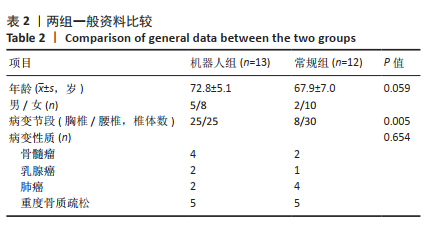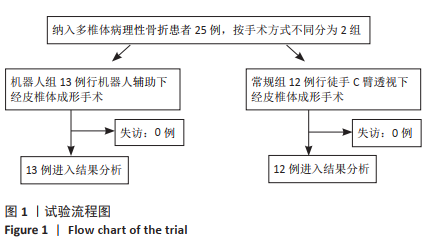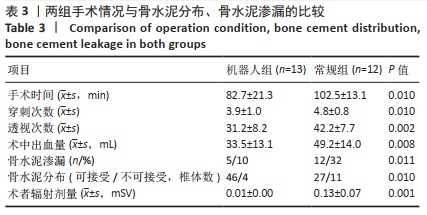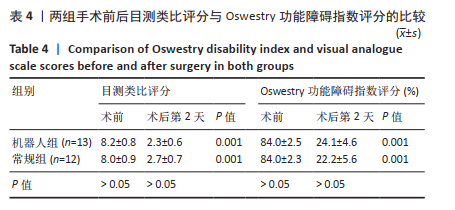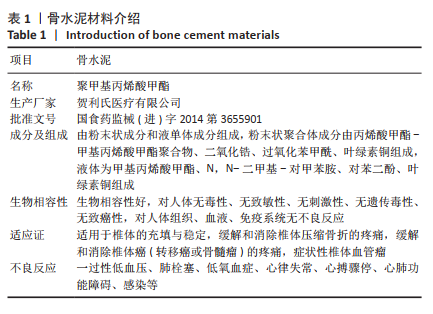[1] ALEXANDRU D, SO W. Evaluation and management of vertebral compression fractures. Perm J. 2012;16(4):46-51.
[2] SI L, WINZENBERG TM, JIANG Q, et al. Projection of osteoporosis-related fractures and costs in China: 2010-2050. Osteoporosis Int. 2015;26(7):1929-1937.
[3] FERLAY J, SOERJOMATARAM I, DIKSHIT R, et al. Cancer incidence and mortality worldwide: sources,methods and major patterns in GLOBOCAN 2012. Int J Cancer. 2015;136(5):E359-E386.
[4] BILSKY MH, LIS E, RAIZER J, et al. The diagnosis and treatment of metastatic spinal tumor. Oncologist. 1999;4(6):459-469.
[5] MACEDO F, LADEIRA K, PINHO F, et al. Bone metastases: an overview. Oncol Rev. 2017;11(1):321.
[6] GALIBERT P, DERAMOND H, ROSAT P, et al. Preliminary note on the treatment of vertebral angioma by percutaneous acrylic vertebroplasty. Neurochirurgie. 1987;33(2):166-168.
[7] LIU J, TANG J, ZHANG Y, et al. Percutaneous vertebral augmentation for osteoporotic vertebral compression fracture in the midthoracic vertebrae (T5-8): A retrospective study of 101 patients with 111 fractured segments. World Neurosurg. 2019;122:e1381-e1387.
[8] RAJAH G, ALTSHULER D, SADIQ O, et al. Predictors of delayed failure of structural kyphoplasty for pathological compression fractures in cancer patients. J Neurosurg Spine. 2015;23(2):228-232.
[9] GERMANEAU A, VENDEUVRE T, SAGET M, et al. A novel approach for biomechanical spine analysis: Mechanical response of vertebral bone augmentation by kyphoplasty to stabilise thoracolumbar burst fractures. J Mech Behav Biomed Mater. 2016;59:291-303.
[10] HUSKISSON EC. Measurement of pain. Lancet. 1974;2(7889): 1127-1131.
[11] YOUNG WF, BROWN D, KENDLER A, et al. Delayed post-traumatic osteonecrosis of a vertebralbody(Kummell’s disease). Acta Orthop Belg. 2002;68(1):13-19.
[12] SCHACHAR NS. An update on the nonoperative treatment of patients with metastatic bone disease. Clin Orthop Relat Res. 2001;1(382): 75-81.
[13] SHIMONY JS, GILULA LA, ZELLER AJ, et al. Percutaneous vertebroplasty for malignant compression fractures with epidural involvement. Radiology. 2004;232(3):846-853.
[14] BATES T. A review of local radiotherapy in the treatment of bone metastases and cord compression. Int J Radiat Oncol Biol Phys. 1992; 23(1):217-221.
[15] JANDAGHI SH, ABDOLHOSEINPOUR H, GHOFRANIHA A, et al. A limb-saving procedure for treatment of arterial cement embolism during lumbar percutaneous vertebroplasty: A case report. J Tehran Heart Cent. 2013;8(1):61-64.
[16] JENSEN A. Incidence of bone metastases and skeletal-related events in breast cancer patients: A population based cohort study in Denmark. BMC Cancer. 2011;24(11):29.
[17] KALOOSTIAN PE, YURTER A, ETAME AB, et al. Palliative strategies for the management of primary and metastatic spinal tumors. Cancer Control. 2014;21(2):140-143.
[18] ALVAREZ L, PEREZ-HIGUERAS A, QUINONES D, et al. Vertebroplasty in the treatment of vertebral tumors: postprocedural outcome and quality of life. Eur Spine J. 2003;12(4):356-360.
[19] LIM BS, CHANG UK, YOUN SM. Clinical outcomes after percutaneous vertebroplasty for pathologic compression fractures in osteolytic metastatic spinal disease. J Korean Neurosurg Soc. 2009;45(6):369-374.
[20] BHATT AD, SCHULER JC, BOAKYE M, et al. Current and emerging concepts in non-invasive and minimally invasive management of spine metastasis. Cancer Treat Rev. 2013;39(2):142-152.
[21] CHI JH, GOKASLAN ZL. Vertebroplasty and kyphoplasty for spinal metastases. Curr Opin Support Palliat Care. 2008;2(1):9-13.
[22] CHEN KY, MA HI, CHIANG YH. Percutaneous transpedicular vertebroplasty with polymethyl methacrylate for pathological fracture of the spine. J Clin Neurosci. 2009;16(10):1300-1304.
[23] Oflfluoglu O. Minimally invasive management of spinal metastases. Orthop Clin North Am. 2009;40(1):155-168.
[24] PFLFLUGMACHER R, BETH P, SCHROEDER RJ, et al. Balloon kyphoplasty for the treatment of pathological fractures in the thoracic and lumbar spine caused by metastasis: One-year follow-up. Acta Radiol. 2007; 48(1):89-95.
[25] KOSE KC, CEBESOY O, AKAN B, et al. Functional results of vertebral augmentation techniques in patho logical vertebral fractures of myelomatous patients. J Natl Med Assoc. 2006;98(10):1654-1658.
[26] QIAN Z, SUN Z, YANG H, et al. Kyphoplasty for the treatment of malignant vertebral compression fractures caused by metastases. J Clin Neurosci. 2011;18(6):763-767.
[27] BARR JD, BARR MS, LEMLEY TJ, et al. Percutaneous verteb roplasty for pain relief and spinal stabilization. Spine (Phila Pa 1976). 2000; 25(8):923-928.
[28] ZOARSKI GH, STALLMEYER MJ, OBUCHOWSKI A. Percutaneous vertebrop lasty: A to Z. Tech Vasc Interv Radiol. 2002;5(4):223-238.
[29] SUN H, YANG Z, XU Y, et al. Safety of percutaneous vertebroplasty for the treatment of metastatic spinal tumors in patients with posterior wall defects. Eur Spine J. 2015;24(8):1768-1777.
[30] 王方永,李建军.胸腰椎椎弓根解剖参数三维分析[J].中国康复理论与实践,2012,18(2):134-136.
[31] MASTRANGELO G, FEDELI U, FADDA E, et al. Increased cancer risk among surgeons in an orthopaedic hospital.Occup Med (Lond). 2005; 55(6):498-500.
[32] SINGER G. Occupational radiation exposure to the surgeon.J Am Acad Orthop. 2005;13(1):69-76.
[33] HARSTALL R, HEINI PF, MINI RL, et al. Radiation exposure to the surgeon during flfluoroscopically assisted percutaneous vertebroplasty:a prospective study. Spine(Phila Pa 1976). 2005;30(16):1893-1898.
[34] IZADPANAH K, KONRAD G, SUDKAMP NP, et al. Computer navigation in balloon kyphoplasty reduces the intraoperative radiation exposure. Spine(Phila Pa 1976). 2009;34(12):1325-1329.
[35] SHAH J, VYAS A, VYAS D. The History of Robotics in Surgical Specialties. Am J Robot Surg. 2014;1(1):12-20.
[36] 王嵘,赵继宗,王德江,等.导航下显微神经外科手术影像漂移的分析[J].北京医学,2002,24(3):155-157.
[37] AUSTIN MS, VACCARO AR, BRISLIN B, et al. Image-guided spine surgery: a cadaver study comparing conventional open laminoforaminotomy and two image-guided techniques for pedicle screw placement in posterolateral fusion and nonfusion models. Spine (Phila Pa 1976). 2002;27(22):2503-2508.
[38] RICHTER M, AMIOT LP, NELLER S, et al. Computer-assisted surgery in posterior instrumentation of the cervical spine: an in-vitro feasibility study. Eur Spine J. 2000;9 Suppl 1(Suppl 1):S65-70.
[39] 田伟,刘亚军,刘波,等.计算机导航在脊柱外科手术应用实验和临床 研究[J].中华骨科杂志,2006,26(10):671-675.
[40] 杨立江,陈华江,陈德玉,等.计算机辅助导航技术在脊柱侧凸手术中应用的初步经验[J].中国矫形外科杂志,2007,15(23):1173-1176.
[41] BARZILAY Y, SCHROEDER JE, HILLER N, et al. Robot-assisted Vertebral Body Augmentation: A Radiation Reduction Tool. Spine(Phila Pa 1976). 2014;39(2):153-157. |
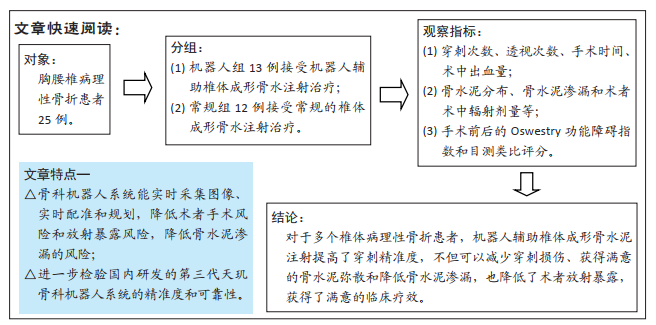 文题释义:
文题释义: